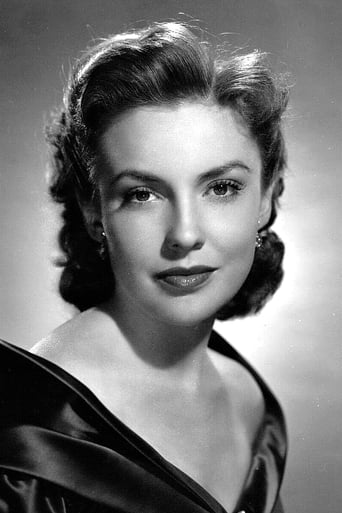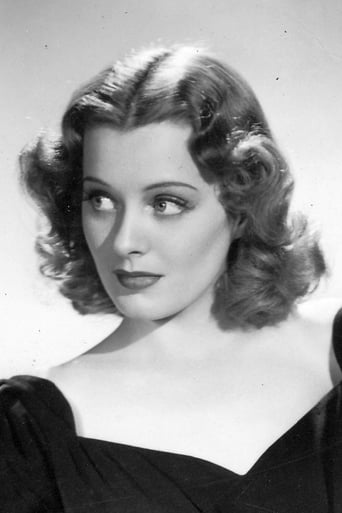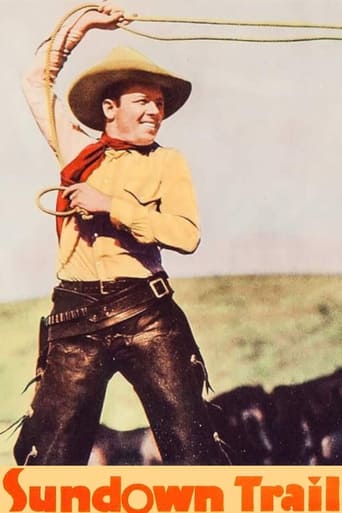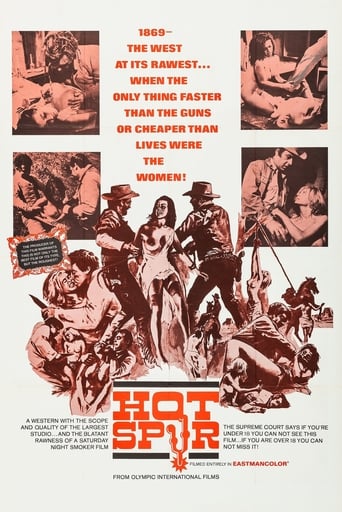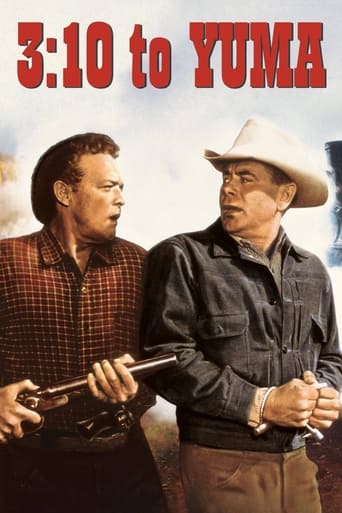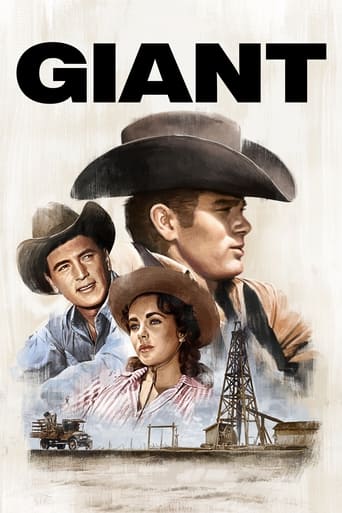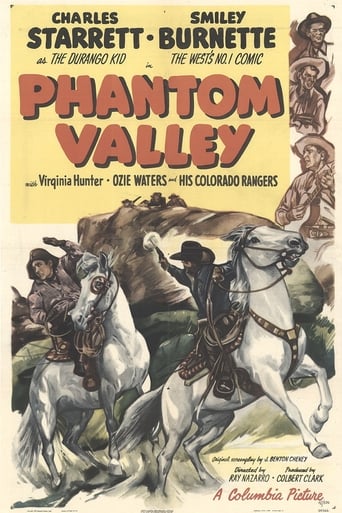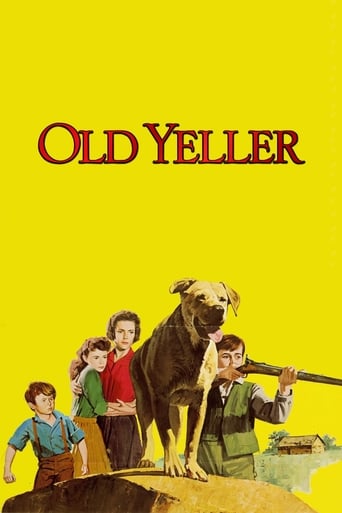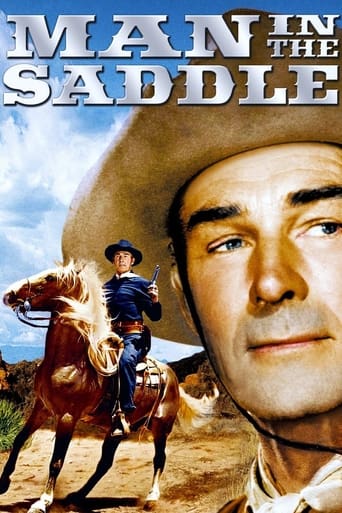
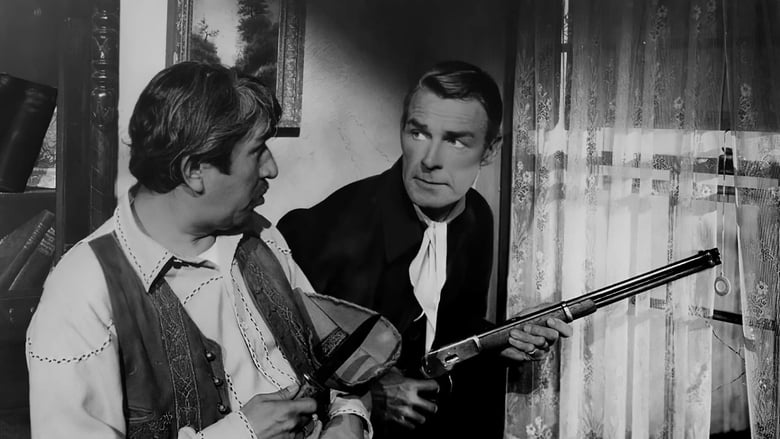
Man in the Saddle (1951)
A small rancher is being harassed by his mighty and powerful neighbor. When the neighbor even hires gunmen to intimidate him he has to defend himself and his property by means of violence.
Watch Trailer
Cast
Similar titles
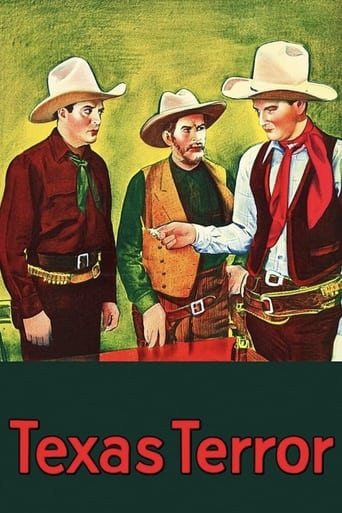
Reviews
It's entirely possible that sending the audience out feeling lousy was intentional
A great movie, one of the best of this year. There was a bit of confusion at one point in the plot, but nothing serious.
The film never slows down or bores, plunging from one harrowing sequence to the next.
An old-fashioned movie made with new-fashioned finesse.
Man in the Saddle is directed by Andre De Toth and adapted to screenplay by Kenneth Gamet from the novel written by Ernest Haycox. It stars Randolph Scott, Joan Leslie, John Russell, Ellen Drew, Alexander Knox, Richard Rober and Guinn Williams. Music is by George Duning and cinematography by Charles Lawton Jr.More known and rightly lauded for the series of Western films he made with Budd Boetticher, it often gets forgotten that Randolph Scott also had a long working relationship with Andre De Toth. Man in the Saddle was the first of six Western films the two men would make together, and it's a pretty impressive start.Sometimes you see words such as routine and standard attributed to a lot of Westerns from the 1950s, and Man in the Saddle is one such film that's unfairly tarred with that brush. Not that the narrative drive is out of the ordinary, the plot essentially sees Randy as a peaceful farmer forced to get nasty when evil land baron flexes his muscles, but the zest of the action, the stunt work, the colour photography (Lone Pine as always a Mecca for Western fans) and Scott, mark this out as a thoroughly entertaining production.Characterisations carry a bit more psychological smarts than your average "B" Western of the era. There's a four way tug-of-love-war operating that is clearly going to spell misery, pain and death for somebody, a capitalist slant that bites hard with its egotistical bully boy overtones, while the obsessive behaviour of the principal players adds another dark cloud over this part of the West. Then there is the action scenes, of which De Toth once again shows himself to be a darn fine purveyor of such directional skills.And so, we get an ace runaway blazing wagon sequence, a stampede, a quite brilliant gunfight in a darkened saloon, a mano-mano fist fight that literally brings the house down – and then continues down a steep ravine, and the closing shoot-out played out during a dust storm doesn't lack for adrenaline rushes. Scott is once again a bastion of Western coolness, more so when he throws off the bright attire he wears for the first half of film, to then switch to black clothes that signifies he's going all bad ass on those who have caused him grief.Undervalued for sure, both as a Scott picture and as a Western movie in general. Don't believe the routine and standard scare mongers, there's good craft here and it's a whole bunch of Oater fun. 7.5/10
I love Randolph Scott westerns and have seen most of his films. However, unlike the vast majority of his wonderful films, this one left me feeling rather indifferent. Some of it is because the plot is oh so familiar, some of it is because the villains aren't particularly believable or interesting (Alexander Knox and Richard Rober were simply too bland for their roles) but I think a lot of it was because the motivations of the baddies were just too vague. It was like they were bad because they were caricatures--not real people. Sure, Knox's character was supposed to be jealous...but this didn't seem enough to explain his actions. And, oddly, for once, Randolph Scott also seemed aimless--at least for part of the film.Another problem, and I've seen this in a couple other Scott films is that the stunt doubles simply didn't look like the people they were doubling for in the film. While the difference between the stunt man and Scott wasn't as bad as the one in I'M GONNA GIT YOU SUCKA!, it was pretty close. Again and again during the fight at the cabin by the waterfall, you could clearly see it wasn't him.Despite all these problems, I am not saying that this is a bad western---it isn't a particularly inspired or interesting one. And, from Randolph Scott you just wouldn't expect ordinary. This was 100% ordinary.
There's a small lake that straddles the boundary separating Will Isham's Skull Ranch and Pay Lankershim's land. Isham (Alexander Knox), a powerful, determined and jealous megalomaniac, offers $50,000 cash if Pay sells his ranch to him this night, Isham's wedding night. It's worth maybe $9,000. There's enough water for both our herds, Pay says. "You don't get the idea," Isham says with a tumbler of brandy in his hand. "I'd only own half a lake. I don't own half of anything, Lankershim. I own it all, lock, stock and barrel. That goes for anything. Whatever I have is mine and mine alone. I'll share with no one." Now Skull's boundary is up against Owen Merritt's land...and it will only be a matter of time before Isham goes after Owen (Randolph Scott). He's even brought in a hired gun to speed things along. And the woman Isham just married? Turns out Laurie Bidwell (Joan Leslie) is the woman Owen loves. She made her choice, however, because she wanted position and money, and that meant Isham, not Owen. After Owen nearly gets killed in a stampede engineered by Isham's men, Laurie is beginning to have doubts about her choice. She'd better remember what Isham told Pay: "Whatever I have is mine alone. I'll share with no one." When Owen's men start getting killed, he decides to do some killing of his own. It's not long before it's just Owen Merritt against the power of Skull, and that means Will Isham and his hired guns. Thank goodness Owen has a few loyal ranch hands and one friend, spunky, feisty Nan Melotte, the blonde young owner of a small ranch next to Owen's. We know things are going to get much rougher in the next hour. Man in the Saddle may be a B western, but it's a Randolph Scott B western. With me, that usually means a strong story even with clichés, most often a good villain or two, enough action to quickly pass the time and, of course, Scott. He was a big guy who could come across as grim, judgmental and dead serious. He also had perfected the persona of an honorable man of action. He had the screen presence to carry even B westerns. He had no trouble dominating his films, even when playing against an alpha male like Lee Marvin. I've always found a good deal of pleasure watching a Randolph Scott western. Joan Leslie has a much more complicated character to play than most B movie westerns call for. Her Laurie Isham comes from a hardscrabble past. She loves, in her way, Owen. She marries Isham because she yearns for position and security. She winds up trying to be loyal to both. Leslie manages to carry it off so well we sort of admire Laurie and how she's trying to handle the fix she's put herself in. To see Joan Leslie at her freshest and friendliest, find a copy of The Sky's the Limit. At barely 18 she stars opposite Fred Astaire and shares a fast, funny song and dance routine with him, "A Lot in Common with You." Leslie just about keeps up with Astaire and he makes it seem easy for her. When she can manage just two air-borne turns (which she does with grace and precision), he hits three but places himself just a little in front of her to disguise the difference. For those fond of pound-'em-into-the-ground fistfights, Man in the Saddle features a lulu. Scott and John Russell, an equally big guy who plays a man with a vicious temper who has a hankerin' for Nan, start walloping each other in a mountain shack, then slip-slide down a rocky, snow covered mountainside going after each other with fists, rocks and tree limbs. The stunt doubles earned their money with this one. Man in the Saddle is no classic, but it turns out to be one of the better westerns Scott made during this period.
Man In The Saddle Is Classic In Every Sense Because It Was A Fantastic Formula So Popular During The Fifties When The Star, Not The Film Pulled The Fans Into The Theater. Scott Is Excellent In The Colorful Location Of Lone Pine, California. Detoth Had Come Aboard As Director Since Usual Scott Director Edwin Marin Had Recently Died Of A Heart Attack. Man In The Saddle Is The Action Western No Longer Produced And Sorely Missed By Many, And If It Is Veiwed With An Idea Of The Time it Was Made One can Almost Feel The Excitement Which Filled Theaters No Longer Enjoyed, As In Those Days. I Rate Man In The Saddle 4 Stars Out Of 4. Billy Holcomb

